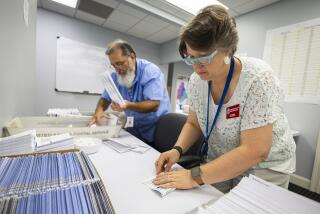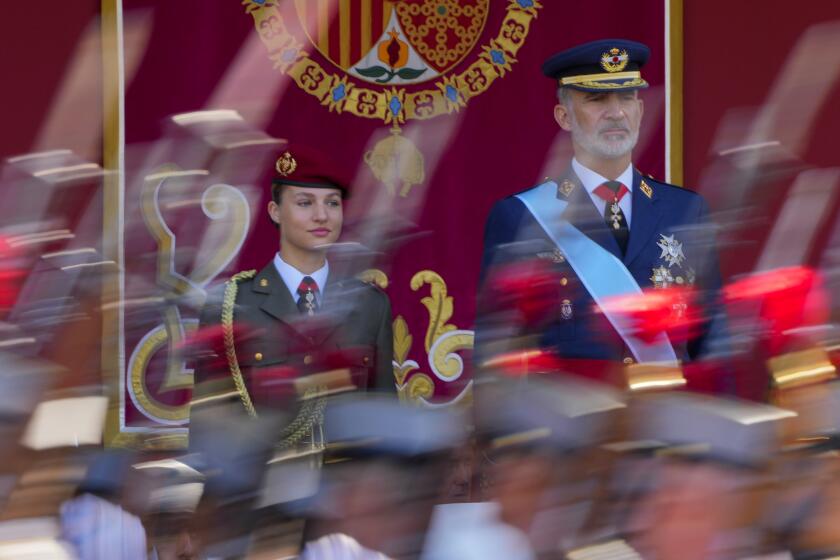U.S. commander in Afghanistan shifts focus to protecting the public
The U.S. and its allies must change their mission to focus on protecting the Afghan people -- even if it means temporarily allowing the Taliban to operate relatively freely in sparsely populated areas, the top U.S. commander in Afghanistan said in an interview Saturday.
Army Gen. Stanley A. McChrystal, who was appointed to overhaul military operations in the country, discussed his new strategy to shift the course of a war that has become increasingly intense.
With the American public growing more anxious about rising death tolls, McChrystal has been charged with showing some progress in the next year.
“Everybody’s watching. I don’t mean just in the United States or Europe; the Taliban is watching, the people of Afghanistan are watching,” said McChrystal, who assumed command last month. “They will judge our commitment to a new strategy, they will judge our resolve to a new strategy, our resolve to succeed.”
The general, who did not say whether he would need additional troops, said his strategy is aimed at separating insurgents from noncombatants and increasing confidence in the Afghan government.
He acknowledged that U.S. and alliance forces cannot routinely enter some areas.
“Practically speaking, there are areas that are controlled by Taliban forces,” he said. Over time, McChrystal said, the command will “reduce” those areas, but the first priority will to be to make sure populated areas are free of insurgent influence.
The U.S. has pulled up a few of its remote combat outposts and firebases in areas where they were doing little to protect the population, military officials said. McChrystal said that though some remote firebases would be eliminated, others would stay if they proved important in keeping insurgents away from populated areas.
“If the insurgents are in remote areas, they don’t have access to what they need for success, which is population,” McChrystal said.
McChrystal said the operation led by U.S. Marines in southern Afghanistan’s Helmand province is a key test of his strategy. Although planned before he took command, McChrystal said the offensive was well timed because it offered an opportunity to show that the U.S. and NATO alliance had changed tactics and would no longer move into an area, fight insurgents, then leave.
“What I don’t think you will see as much of is big unit sweeps,” he said. “Historically it doesn’t work, but almost every counterinsurgency tries it and relearns the lesson.”
Because of that familiar pattern, Afghan leaders in Helmand fear that the U.S. may leave after their clearing operations are complete, allowing Taliban forces to return.
McChrystal said U.S. forces must prove they are going to stay and help local governments get reestablished.
The interview took place on a wooden deck next to McChrystal’s office just as the sun was setting on it -- both figuratively and literally. One of the general’s few places of quiet repose, the deck, outfitted with an umbrella and chairs, will soon be torn up to create a mini-war room.
“So much for the ambience,” McChrystal said.
McChrystal is in the midst of conducting a 60-day assessment of the war. He said he will wait until the last moment in mid-August to submit that report. But he has begun discussing his findings with officials in Washington.
In addition to implementing the new counterinsurgency strategy, McChrystal said, a key to turning around the war effort is improving and speeding the training of Afghan security forces; using intelligence and reconnaissance aircraft more effectively and overhauling how the military command operates and makes decisions.
McChrystal is overhauling his main command center, allowing Afghan military and police to participate in morning updates and share their information.
He also intends to build a series of “fusion cells” around the country where information from spy planes and other kinds of intelligence can quickly be turned into operations.
The commander has also been leaning on the U.S. military and other parts of the government to send their best people to the war. In a teleconference Friday with White House and Pentagon officials, McChrystal offered an assessment and said experienced hands were needed for the fight.
“It is important we put talent to this issue,” he said. “We have to think our way through this problem; it is not going to be won through brute force.”
McChrystal has also ordered a review of how the military uses reconnaissance planes such as Predator drones and U-2 spy planes.
Some commanders use the drones to troll for information over a wide area. McChrystal wants to end such air patrols and instead use the Predators to watch specific targets.
“If you don’t know what you are looking for . . . then it becomes wasteful,” McChrystal said.
He said he and his advisors have determined that they can both increase the rate at which the Afghan security forces are trained and build the size of the force beyond the current goals. Under current plans, the U.S. is trying to create an army of 135,000 soldiers and a police force of 80,000 officers by 2011.
The recommendation is still being reviewed, but the military has begun to overhaul the training effort. McChrystal is pushing for a much closer partnership between Afghan security forces and units from the U.S. and North Atlantic Treaty Organization.
In addition to trainers who live and work with Afghan security forces, McChrystal wants international military units to work more closely with Afghans.
“Whether we grow the Afghan security forces faster or not, partnering closer is to our benefit and we can do it better,” McChrystal said.
Some military officials have said turning around the war in Afghanistan will not happen as quickly as in Iraq because there is little likelihood that fighters in Afghanistan will lay down their arms en masse as many Sunni Arabs in Iraq did.
But McChrystal said he thought there was significant potential to “re-integrate” Taliban fighters and leaders into Afghan society because most fighters are neither politically motivated nor ideological.
Instead, he said, they are under the sway of charismatic leaders, working for pay or frustrated with their local government, meaning that they can be persuaded to stop fighting.
--
More to Read
Sign up for Essential California
The most important California stories and recommendations in your inbox every morning.
You may occasionally receive promotional content from the Los Angeles Times.










